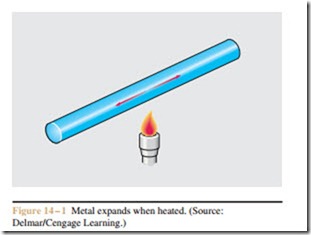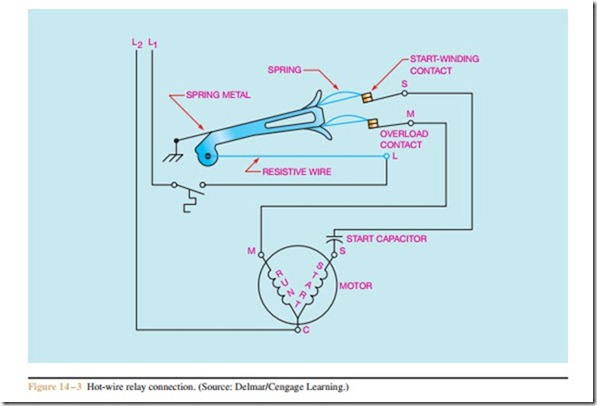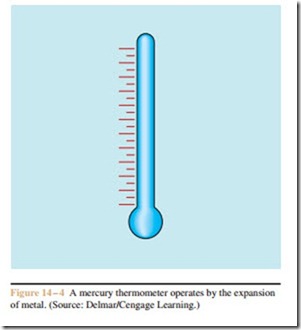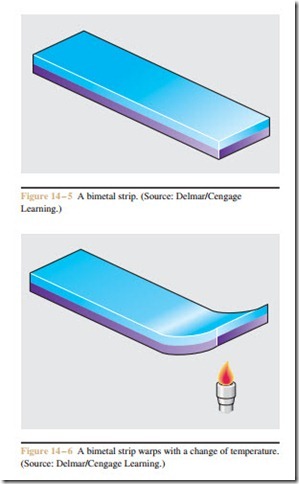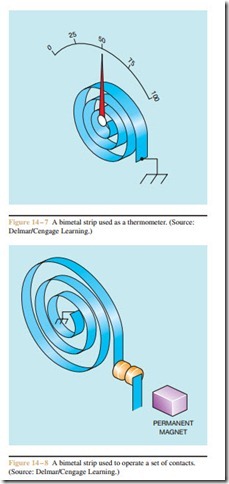There are many times when the ability to sense temperature is of great importance. The industrial electrician will encounter some devices designed to change a set of contacts with a change of temperature and other devices used to sense the amount of temperature. The method used depends a great deal on the applications of the circuit and the amount of temperature that must be sensed.
Consider the metal bar shown in Figure 14 – 1. When the bar is heated, its length expands. When the metal is permitted to cool, it will contract. Although the
A very common and reliable method for sensing temperature is by the expansion of metal. It has long been known that metal expands when heated. The amount of expansion is proportional to two factors:
1. The type of metal used.
2. The amount of temperature.
amount of movement due to contractions and expansion is small, a simple mechanical principle can be used to increase the amount of movement (Figure 14 – 2).
The metal bar is mechanically held at one end. This permits the amount of expansion to be in one direction only. When the metal is heated and the bar expands, it pushes against the mechanical arm. A small movement of the bar causes a great amount of movement in the mechanical arm. This increased movement in the arm can be used to indicate the temperature of the bar by attaching a pointer and scale, or to operate a switch as shown. It should be understood that illustrations are used to convey a principle. In actual practice, the switch shown in Figure 14 – 2 would be spring loaded to provide a “snap” action for the contacts. Electrical contacts must never be permitted to open or close slowly. This produces poor contact pres- sure and will cause the contacts to burn or will cause erratic operation of the equipment they are intended to control.
Hot-wire Starting Relay
A very common device that uses the principle of expanding metal to operate a set of contacts is the hot- wire starting relay found in the refrigeration industry. The hot-wire relay is so named because it uses a length of resistive wire connected in series with the motor to sense motor current. A diagram of this type of relay is shown in Figure 14 – 3.
When the thermostat contact closes, current can flow from line L1 to terminal L of the relay. Current then flows through the resistive wire, the movable arm, and the normally closed contacts to the run and start windings. When current flows through the resistive wire, its temperature increases. This increase of temperature causes the wire to expand in length. When the length increases, the movable arm is forced down- ward. This downward pressure produces tension on the springs of both contacts. The relay is so designed that the start contact will snap open first, disconnecting the motor start winding from the circuit. If the motor current is not excessive, the wire will never become hot enough to cause the overload contact to open. If the motor current should become too great, however, the temperature of the resistive wire will become high enough to cause the wire to expand to the point that it will cause the overload contact to snap open and dis- connect the motor run winding from the circuit.
The Mercury Thermometer
Another very useful device that works on the principle of contraction and expansion of metal is the mercury thermometer. Mercury is a metal that remains in a liquid state at room temperature. If the mercury is confined in a glass tube as shown in Figure 14 – 4, it will rise up the tube as it expands due to an increase in temperature. If the tube is calibrated correctly, it pro- vides an accurate measurement for temperature.
The Bimetal Strip
The bimetal strip is another device that operates by the expansion of metal. It is probably the most common heat sensing device used in the production of room thermostats and thermometers. The bimetal strip is made by bonding two dissimilar types of metal together (Figure 14 – 5). Since these two metals are not alike, they have different expansion rates. This causes the strip to bend or warp when heated (Figure 14 – 6). A bimetal strip is often formed into a spiral shape, as shown in Figure 14 – 7. The spiral permits a longer bimetal strip to be used in a small space. A long bimetal strip is desirable because it exhibits a greater amount of movement with a change of temperature.
If one end of the strip is mechanically held and a pointer is attached to the center of the spiral, a change in temperature will cause the pointer to rotate. If a calibrated scale is placed behind the pointer, it becomes a thermometer. If the center of the spiral is held in position and a contact is attached to the end of the
bimetal strip, it becomes a thermostat. A small permanent magnet is used to provide a snap action for the contacts (Figure 14 – 8). When the moving contact reaches a point that is close to the stationary contact, the magnet attracts the metal strip and causes a sudden closing of the contacts. When the bimetal strip cools, it pulls away from the magnet. When the force of the bimetal strip becomes strong enough, it overcomes the force of the magnet and the contacts snap open.
Thermocouples
In 1822, a German scientist named Seebeck discovered that when two dissimilar metals are joined at one end, and that junction is heated, a voltage is produced (Figure 14 – 9). This is known as the Seebeck effect. The device produced by the joining of two dissimilar metals for the purpose of producing electric- ity with heat is called a thermocouple. The amount of voltage produced by a thermocouple is determined by:
1. The type of materials used to produce the thermo- couple.
2. The temperature difference of the two junctions.
